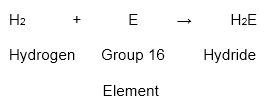Oxygen is one of the most important elements in the universe. Don’t you agree? However, do you know that there are many other elements that behave like oxygen? In this chapter, we will read about the Group 16 elements. Let us see what is similar between oxygen and the other members. We will also see why oxygen is the most important member of that group. So let’s begin.
Suggested Videos
Occurrence and General Characteristics
The elements oxygen, sulfur, selenium, tellurium and polonium comprise the 16th vertical column or VI A group elements in the currently used long type of periodic table.

The initial four elements of the group are together termed as chalcogens or ore-forming elements. This is because an extensive number of metal ores are found in the earth’s crust as sulfides or oxides. Oxygen is the most plenteous element that is accessible in nature. It shapes 20.946% of air by volume and 46.6% of the world’s mass generally as silicates and different compounds like carbonates, oxides, and sulfates.
The vast majority of the oxygen in the air is delivered by photosynthesis in plants. It additionally occurs as ozone. Sulfur is the sixteenth most inexhaustible element. Sulfur in its combined state is found in ores.
Electronic Configuration of Group 16 Elements
Group 16 elements have 6 electrons in their valence shell and their general electronic configuration is ns2np4.
Element |
Electronic Configuration |
| Oxygen | [He] 2s2 2p4 |
| Sulphur | [Ne] 3s2 3p4 |
| Selenium | [Ar] 3d10 4s2 4p4 |
| Tellurium | [Kr] 4d10 5s2 5p4 |
| Polonium | [Xe] 4f14 5d10 6s2 6p4 |
Atomic and Physical Properties and the Trends of Group 16 elements
- Atomic and Ionic Radii: The atomic and ionic radius increases as we move from Oxygen to Polonium.
- Ionization Enthalpy: Ionization enthalpy decreases with increase in the size of the central atom. Therefore, it decreases as we move from Oxygen to Polonium since the size of the atom increases as we move down.
- Electron Gain Enthalpy: The electron gain enthalpy decreases with increase in the size of the central atom moving down the group. Oxygen molecule has a less negative electron gain enthalpy than sulfur. This is on the grounds that Oxygen, because of its compressed nature encounter more repulsion between the electrons effectively present and the approaching electron.
- Electronegativity: The electronegativity decreases as we move down the group. Therefore, it decreases as we move from oxygen to polonium due to increase in nuclear size.Learn about Electronegativity here in detail.
- Nature of the Group 16 Elements: Oxygen and Sulfur are non-metals, Selenium and Tellurium are metalloids and Polonium is a metal under typical conditions. Polonium is a radioactive element.
- Allotropy: Each one of the element of group 16 displays allotropy. Oxygen has two allotropes: Oxygen and Ozone. Sulphur exists as many allotropic forms but only two of them are stable, which are: Rhombic Sulphur and Monoclinic Sulphur. Selenium and Tellurium are found in both amorphous and crystalline forms.
- The Melting and Boiling Points: As the atomic size increases from oxygen to tellurium, the melting and boiling points also increase. The huge distinction between the melting and boiling points of oxygen and sulfur might be clarified on the premise that oxygen exists as a diatomic atom while sulfur exists as a polyatomic particle.
- Oxidation States: The group 16 elements have a configuration of ns2 np4 in their outer shell, they may accomplish noble gas configuration either by the gain of two electrons, framing M-2 or by sharing two electrons, in this manner shaping two covalent bonds.
Thus, these elements indicate both negative and positive oxidation states. The regular oxidation states showed by the elements of group 16 incorporate -2, +2, +4 and + 6.
Chemical Properties
The group sixteen elements react with hydrogen to form hydrides of the sort H2E, where E could be any element- oxygen, sulfur, selenium, tellurium or polonium.
The Physical States of Hydrides of Group 16 Elements
Water is an odourless and colourless liquid but the hydrides of the various elements of this group are poisonous gases which are colourless with disagreeable smells.
The boiling point of these hydrides extraordinarily diminishes from water to hydrogen sulfide, and after that increases. Water has an anomalously high boiling point since its particles are bonded with each other by the hydrogen bonds in both its liquid as well as solid states.
Learn more about the s Block elements here.
Solved Example for You
Q: Write a note on the acidic character of hydrides of Group 16 elements.
Ans: There is an expansion in acidic nature of hydrides from H2O to H2Te. The development in acidic character is a result of the decrease in the H-E bond separation enthalpy from H2O to H2Te. Except for water, the different hydrides go about as reducing agents. The reducing property of these hydrides increments from H2S to H2Te.
Every one of the elements of group 16 reacts with oxygen to shape dioxides and trioxides. Both dioxides and trioxides are acidic in nature. Sulfur trioxide is the primary basic triode in this group. Sulfur trioxide at room temperature is a solid and exists in three specific structures – alpha, beta and gamma.
Elements of group 16 accommodate an enormous assortment of halides of the sort EX6, EX2, and EX4, where E is the element of group 16 elements and X is a halogen. Among all hexahalides, just hexafluorides are latent. They encounter sp3d2 hybridization, and along these lines, have octahedral geometry.








Leave a Reply